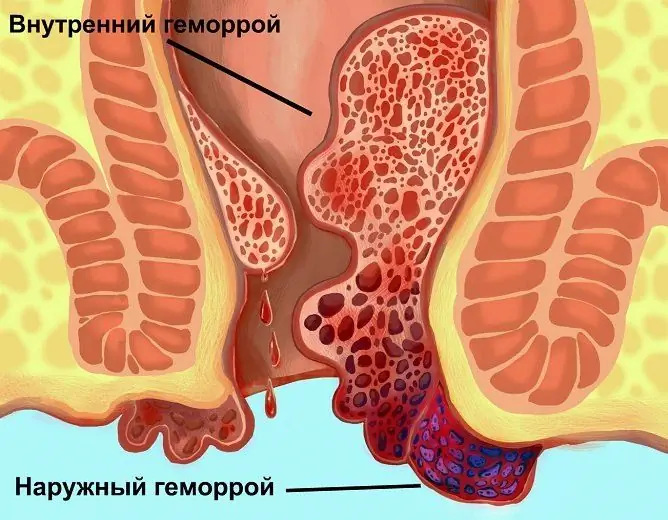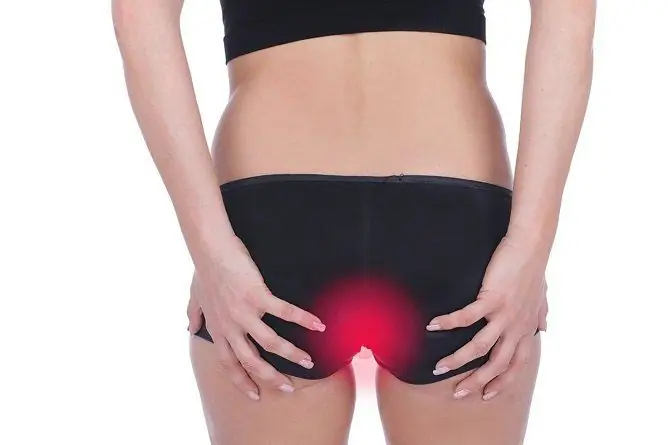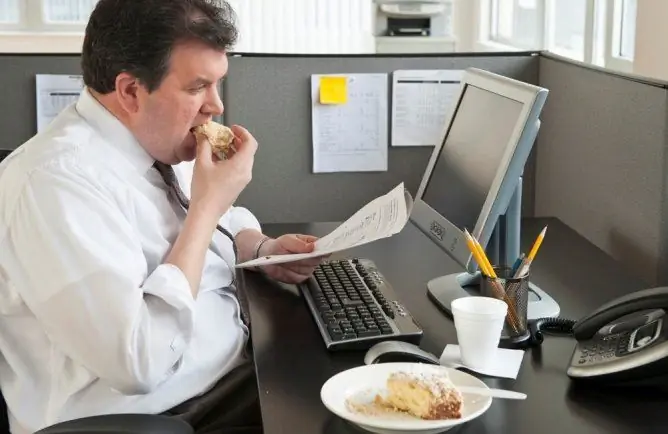- Author Rachel Wainwright [email protected].
- Public 2023-12-15 07:39.
- Last modified 2025-11-02 20:14.
Treatment of internal hemorrhoids: how to treat, causes, signs, prevention
The content of the article:
- The causes of internal hemorrhoids
- Signs of internal hemorrhoids
- Diagnostics
- Internal hemorrhoid treatment
- Treatment of internal hemorrhoids at home
- Prevention
Treatment of internal hemorrhoids is an issue that is relevant for many patients. According to medical statistics, approximately 60% of adults have symptoms of the disease. However, the percentage of those who seek medical help is much smaller, which is associated with the delicacy of the problem and the shyness of patients, and sometimes inattention to their health.

Internal hemorrhoids often do not manifest themselves at an early stage
Internal hemorrhoids - this is one of the most widespread proctological diseases, which is characterized by the expansion of the cavernous (cavernous) venous bodies located in the thickness of the terminal (terminal) rectum. Lack of the necessary therapy can lead to the development of rather serious complications, including:
- inflammation of the hemorrhoids;
- thrombosis and necrosis of hemorrhoids;
- bleeding;
- Iron-deficiency anemia;
- anal fissure;
- paraproctitis.
That is why the question of how to treat internal hemorrhoids, and whether it is possible to do it at home with folk remedies, is very relevant for a large number of people.
The causes of internal hemorrhoids
The main reason for the formation of hemorrhoids is the long-term increased intrarectal pressure, which can be caused by various factors, for example, chronic constipation.
In women, pregnancy is often the cause of hemorrhoids. As the fetus develops and grows, it puts pressure on the venous vessels of the pelvic organs, disrupting the blood flow through them. During labor attempts, the pressure inside the rectum increases many times over, which also creates the preconditions for the occurrence of internal hemorrhoids.
In men, the development of the disease is often caused by hard physical labor, weightlifting or, on the contrary, sedentary work, including driving.
Predisposing factors, in addition to those listed above, are:
- hereditary predisposition to the weakness of the vascular wall;
- obesity;
- sedentary lifestyle;
- abuse of spicy and salty foods;
- abuse of alcoholic beverages;
- tumors of the pelvic organs.
Signs of internal hemorrhoids
Internal hemorrhoids can be asymptomatic for a long time. This is due to the fact that there are few nerve endings in the walls of the rectum. Usually, the first sign of the disease is the appearance of blood from the anus after a bowel movement.
In the future, other symptoms arise:
- burning and itching in the anus;
- discomfort or pulling pain in the rectum.
If the treatment of internal hemorrhoids is not started, the nodes gradually begin to fall out. At first, they are adjusted independently, then manually, over time they cease to adjust at all. At the same time, they can be impaired, which leads to their thrombosis, followed by necrosis. One of the first symptoms of this complication is the sudden onset and rapid onset of pain in the anus.
Internal hemorrhoids, accompanied by regular bleeding, leads to the development of iron deficiency anemia as a result of chronic blood loss.
Diagnostics
Diagnosis of internal hemorrhoids is carried out by a proctologist on the basis of a characteristic clinical picture and data of rectal examination. If necessary, the patient is referred for anoscopy or sigmoidoscopy.

In some cases, the diagnosis of internal hemorrhoids is carried out using sigmoidoscopy
Without a doctor's examination and an accurate diagnosis, treatment is not prescribed. This is due to the fact that similar symptoms can be observed in a number of other diseases of the rectum (polyps, malignant tumors) that require a completely different medical tactics.
Internal hemorrhoid treatment
How and how to treat internal hemorrhoids? Treatment can be carried out both conservatively and surgically, depending on the stage of the disease. Conservative therapy is usually prescribed for the uncomplicated course of the disease in the initial stages. Surgical tactics are used mainly at a late stage, as well as with the development of complications (infringement, necrosis, suppuration of the node).
Drug therapy of internal hemorrhoids is carried out by individual selection of drugs of several drug groups:
- Venotonics are drugs that act on the walls of venous vessels, increasing their tone. This group includes Vasoket, Phlebodia, Detralex, horse chestnut extract. They are available both in tablet form and in the form of rectal suppositories for local treatment.
- Anti-inflammatory drugs. They can be steroid (suppositories with hydrocortisone) and non-steroidal (ointment or suppositories with indomethacin).
- Means that improve microcirculation and thrombolytics - prevent the formation of blood clots in hemorrhoids, are used in topical preparations (Troxevasin or Heparin ointment).
- Analgesics - designed to relieve pain. Both local anesthetics (suppositories with Anestezin or Novocaine) and non-steroidal anti-inflammatory drugs (suppositories with indomethacin) can be used.
- Antiseptics - suppress the inflammatory process in the hemorrhoids. These include ichthyol ointment or candles, infusions of sea buckthorn, calendula.
- Means that increase tissue regeneration - have a pronounced wound-healing effect. These include: Methyluracil, propolis, sea buckthorn oil.
- Hemostatic drugs. They can be prescribed in the form of tablets or injections (Vikasol, Ditsinon), as well as in the form of suppositories (Thrombin).
The selection of the drug treatment regimen for internal hemorrhoids for each patient should be carried out by the proctologist, taking into account the stage of the disease, the presence or absence of complications, the age and general condition of the patient.
In addition to drug therapy, the patient is advised to follow a diet with sufficient fiber content, which promotes gentle daily bowel movements.
At 1 degree (stage) of internal hemorrhoids, minimally invasive modern methods, such as infrared photocoagulation or sclerotherapy, are currently used to remove nodes. Feedback from patients and specialists about their effectiveness is almost always positive.
Surgical treatment of stages 2 and 3 of the disease can be carried out using different methods (ligation of the vessels feeding the node, ligation with latex rings, cryotherapy). Treatment of hemorrhoids at 4 stages consists in surgical excision of the nodes.
Surgical treatment of internal hemorrhoids can quickly improve the patient's condition.
Treatment of internal hemorrhoids at home
Modern medicine has a wide arsenal of drugs for the treatment of internal hemorrhoids. However, folk remedies remain relevant and can be included in the scheme of complex therapy for the disease. However, it should be understood that their use should be carried out only with the permission of the attending physician.
With a slight inflammation of the hemorrhoids, traditional medicine recommends using homemade candles made from candied honey or cut from a raw potato tuber. "Candles" made of aspen leaves rolled into a dense tube also have a good anti-inflammatory effect.

Folk remedies in the treatment of internal hemorrhoids can be effective only at an early stage.
To reduce the severity of the inflammatory process and eliminate pain with internal hemorrhoids, cool sessile baths with herbal infusions (calendula, chamomile, yarrow, St. John's wort) help.
Fresh rowan juice, rich in flavonoids, has a slight venotonic effect. It is recommended to take it three times a day, 50 ml. If desired, in order to improve the taste, you can add a teaspoon of honey to the juice.
Many patients believe that traditional methods of treating internal hemorrhoids are much more effective and safer than therapy with modern pharmacological agents. In fact, this opinion is wrong. It should be understood that such treatment can be effective only at the initial stage of internal hemorrhoids. But during this period, the disease is almost asymptomatic and is almost never diagnosed. With hemorrhoids 2-3 stages, traditional medicine is ineffective, if treated only with such methods, the pathology will progress rapidly.
Prevention
Internal hemorrhoids are a chronic condition. Both conservative and surgical treatment is aimed at eliminating symptoms, improving the condition of patients, and reducing the risk of complications.
The primary (prevention of disease) and secondary (prevention of exacerbations) prevention of internal hemorrhoids is the same. It includes the following activities:
- regular physical education;
- daily walks in the fresh air;
- wearing special bandages during pregnancy;
- refusal to systematically lift weights.
Proper nutrition is of great importance in the prevention of hemorrhoids. Food should be taken 5-6 times a day in small portions. They reduce the content of refined products in the diet (polished rice, sugar, premium flour). It is necessary to consume fruits and vegetables, fermented milk products daily in sufficient quantities. This diet helps to improve digestion, regular bowel movements. Patients with chronic constipation are advised to drink a glass of cold water with a teaspoon of honey or a decoction of dried apricots in the morning on an empty stomach.
YouTube video related to the article:

Elena Minkina Doctor anesthesiologist-resuscitator About the author
Education: graduated from the Tashkent State Medical Institute, specializing in general medicine in 1991. Repeatedly passed refresher courses.
Work experience: anesthesiologist-resuscitator of the city maternity complex, resuscitator of the hemodialysis department.
Found a mistake in the text? Select it and press Ctrl + Enter.






